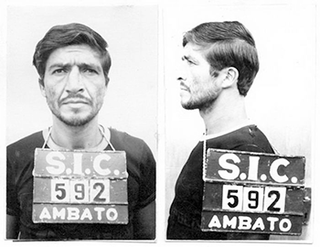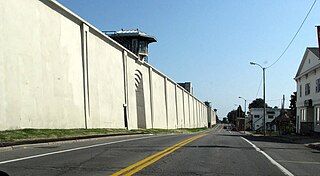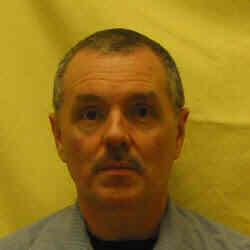Related Research Articles

Cajemé was a Yaqui military leader in the Mexican state of Sonora. Cajemé or Kahe'eme means 'one who does not stop to drink [water]' in the Yaqui language and was originally a clan name, used by Cajemé's father.

San Quentin Rehabilitation Center (SQ), formerly known as San Quentin State Prison, is a California Department of Corrections and Rehabilitation state prison for men, located north of San Francisco in the unincorporated place of San Quentin in Marin County.

Pedro Alonso López, also known as The Monster of the Andes, is a Colombian serial killer, child rapist, and fugitive who murdered a minimum of 110 people, mostly young women and girls, from 1969 to 1980. López claimed to have murdered over 300 people. He is considered by many as one of the most prolific serial killers and rapists in history.

Clinton Correctional Facility is a New York State Department of Corrections and Community Supervision maximum security state prison for men located in the Village of Dannemora, New York. The prison is sometimes colloquially referred to as Dannemora, although its name is derived from its location in Clinton County, New York. The southern perimeter wall of the prison borders New York State Route 374. Church of St. Dismas, the Good Thief, a church built by inmates, is located within the walls. The prison is sometimes referred to as New York's Little Siberia, due to the cold winters in Dannemora and the isolation of the upstate area. It is the largest maximum-security prison and the third-oldest prison in New York. The staff includes about 1,000 officers and supervisors.
Cócorit is a town located in the municipality of Cajeme in the southern part of the Mexican state of Sonora. The name of the town is derived from the Yaqui word for a chili pepper, ko'oko'i. Cócorit and the municipality of Cajeme are within the Yaqui River Valley. The comisario municipal of Cajeme is Ing. Arturo Soto Valenzuela. Cócorit reported a 2005 census population of 7,953 inhabitants, and is the fifth-largest town in the municipality of Cajeme.

María Delfina González Valenzuela, María del Carmen González Valenzuela (1918–1969), María Luisa González Valenzuela and María de Jesús González Valenzuela, known as Las Poquianchis, were four sisters from the north-central Mexican state of Guanajuato. From 1950 until 1964, the sisters ran "Rancho El Ángel"', the locus of their largescale prostitution ring and the site of the murder of at least 91 people, but it is believed that the four sisters killed more than 150 people or even more than 200 people. Guinness World Records called them the "most prolific murder partnership".

Chester Dewayne Turner is an American serial killer and sex offender who was sentenced to death for sexually assaulting and murdering fourteen women and an unborn baby in Los Angeles between 1987 and 1998.

Luis Alfredo Garavito Cubillos, also known as La Bestia or Tribilín ("Goofy"), was a Colombian serial killer, sex offender, pedophile, and necrophile who sexually assaulted 200 victims before sexually assaulting and murdering 193 victims, mostly young men and boys from 1992 to 1999 in western Colombia.

The Mayo or Yoreme are an Indigenous group in Mexico, living in southern Sonora, northern Sinaloa and small settlements in Durango.

Mule Creek State Prison (MCSP) is a California State Prison for men. It was opened in June 1987, and covers 866 acres (350 ha) located in Ione, California. The prison has a staff of 1,242 and an annual operating budget of $157 million.

Quiriego is a small town and the county seat of the Municipality of Quiriego, located in the southeast of the Mexican state of Sonora.

Donald Harvey was an American serial killer who claimed to have murdered 87 people, though he has 37 confirmed victims. He was able to do this during his time as a hospital orderly. His spree took place between 1970 and 1987.

Derrick Todd Lee, also known as The Baton Rouge Serial Killer, was an American serial killer who, from 1998 to 2003, terrorized the areas surrounding Baton Rouge and Lafayette, Louisiana, by committing the murders of at least seven women.
Richard Choque Flores is a Bolivian serial killer and rapist who killed at least two women in 2021, shortly after being released from a prior conviction. For the latter crimes, he was sentenced to 30 years imprisonment.
Diego Casanova is an Argentine serial killer who murdered six people between 2004 and 2016. Casanova is known as The Prisoner Killer as he murdered five inmates while imprisoned. Additionally, he participated in sixty-seven fights and several riots in prison. Experts describe Casanova as an extremely dangerous prisoner with psychopathic behavior, and one of the cruelest serial killers in Argentine history.
References
- ↑ "History of the serial killers in Sonora". culturacolectiva.com (in Spanish). May 27, 2016. Retrieved March 3, 2020.
In the town of Huatabampo, Sonora, a story floats on the streets that will leave you feeling helpless. In 1949, there were four subjects who castrated and murdered their enemies, a cruel and excessive sample of the unusual and mystical reality of the Mayan Indians. This murder story traveled beyond a geographical barrier to the point that the simple phrase "Beware of Los Huipas" marked a time of terror and anxiety...
- 1 2 3 4 E56: Los Huipas (with Raúl G. Meneses) (in European Spanish), retrieved March 25, 2020
- 1 2 "InfoCajeme.com: Tesopaco: The last execution in Sonora". InfoCajeme.com. Retrieved March 25, 2020.
When the death sentences were applied to these people, there were also other inmates who were awaiting their application in prison, among them, four Mayan indigenous people whose crimes shocked Sonoran society at the time. They were Adelaido Huipas Quijano, Leonardo Yocupicio Huipas, Eusebio Yocupicio Soto and Basilio Humo Valenzuela. However, despite the fact that the judge of the First Instance sentencing them to death, they appealed the sentence, and it was later changed to 30 years, having to serve in the state capital. Eusebio Yocupicio Sota and Basilio Humo Valenzuela died in the Hermosilla prison in Sonora, the other two were imprisoned for thirty years.
- 1 2 Yocupicio, Emilia Buitimea (2015-10-21). "Los huipas: los míticos asesinos seriales de Sonora". Vice (in Spanish). Retrieved 2020-03-25.
- ↑ "Huipas: seven were skinned for homophobic ridicule". www.elgrafico.mx (in Spanish). Retrieved March 25, 2020.